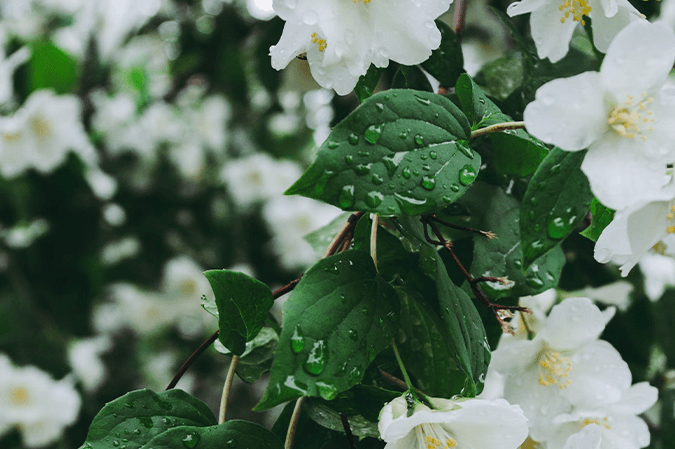Jasmine refers to a group of flowering plants in the genus Jasminum in the family Oleaceae. There are about 200 species of jasmine, native to tropical and subtropical regions of Eurasia, Australasia, and Oceania. Jasmine is renowned for its highly fragrant flowers, which are often used in perfumes, teas, and traditional medicine.
Description
Jasmine plants can grow as shrubs, vines, or ground covers, depending on the species. They are usually evergreen, although some species are deciduous. Jasmine plants produce small, star-shaped flowers that are most commonly white or yellow, although some species may have pinkish flowers. The flowers are typically clustered and bloom in the evening, emitting a sweet fragrance that is strongest at night.
Common Features
- Flowers: Jasmine flowers are small, typically five-petaled, and are highly fragrant. They usually bloom in clusters and are most commonly white, though yellow and pink varieties also exist. The flowers often open at night or early in the morning, which is when they release their strong, sweet fragrance.
- Leaves: The leaves of jasmine plants are usually opposite and pinnate, with 5-9 leaflets. The leaves are typically glossy green, providing a lush background to the delicate flowers.
- Growth Habit: Jasmine can grow as a vine, shrub, or ground cover, depending on the species. The plants are often climbing and can be trained to grow on trellises or other structures, making them popular in gardens and landscaping.
- Fruit: Some jasmine species produce small, berry-like fruits, although these are not typically the plant’s most notable feature.
Role in the Ecosystem
- Pollinator Attraction: Jasmine flowers are highly attractive to pollinators, including bees, butterflies, and moths. The strong fragrance of jasmine, especially at night, draws nocturnal pollinators, which play a crucial role in the reproduction of these plants.
- Habitat: Jasmine plants can provide shelter and food for various insects and small animals. The dense foliage offers protection, while the nectar-rich flowers serve as a food source for pollinators.
- Soil Health: Jasmine plants, particularly those grown as ground covers, can help prevent soil erosion by stabilizing the soil with their root systems. They also contribute organic matter to the soil as leaves and flowers decompose.
Importance
- Ornamental Value: Jasmine is highly prized for its ornamental value in gardens and landscapes. Its beautiful, fragrant flowers make it a popular choice for growing on trellises, arbors, and as a ground cover.
- Culinary Uses: Jasmine flowers are used in culinary applications, most notably in jasmine tea, which is made by infusing the flowers with green or white tea leaves. The flowers are also used to flavor desserts and other dishes in some cultures.
- Aromatic and Medicinal Uses: Jasmine is widely used in the perfume industry for its fragrance. Jasmine oil, extracted from the flowers, is used in aromatherapy for its calming and relaxing effects. In traditional medicine, jasmine is believed to have various health benefits, including antiseptic, anti-inflammatory, and aphrodisiac properties.
- Cultural Significance: Jasmine holds cultural significance in many parts of the world. It is the national flower of countries such as Pakistan, Indonesia, and the Philippines. Jasmine is often used in religious and cultural ceremonies and is a symbol of love, purity, and beauty in various cultures.
Interesting Facts
- Nocturnal Blooms: Jasmine flowers are known for their nocturnal blooming. The fragrance is strongest at night, which is why it is often called “Queen of the Night.”
- Symbolism: In many cultures, jasmine symbolizes love and romance. In some traditions, jasmine flowers are used to make garlands for weddings and religious ceremonies.
- Perfume Industry: Jasmine is one of the most important flowers in the perfume industry. It takes about 8,000 jasmine flowers to produce just one gram of jasmine oil, making it one of the most expensive natural oils in the world.
- Jasmine Tea: Jasmine tea is a popular beverage in China and other parts of Asia. It is typically made by placing jasmine flowers on top of dried tea leaves overnight, allowing the fragrance to infuse the tea.
Sources
- “The Scented Garden: A Guide to Fragrant Plants” by Rosemary Verey
- “Jasmine and Its Uses: A Comprehensive Guide” by Lalit M. Bharucha
- Royal Horticultural Society – Jasmine Plant Information



